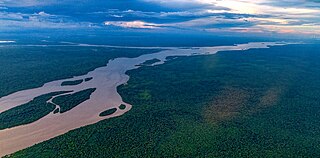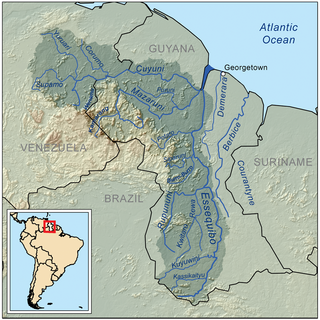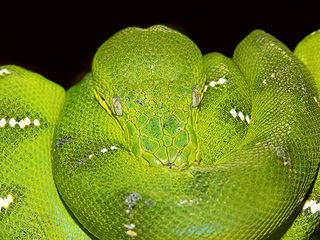
Georgetown is the capital and largest city of Guyana. It is situated in Demerara-Mahaica, region 4, on the Atlantic Ocean coast, at the mouth of the Demerara River. It is nicknamed the "Garden City of the Caribbean." It is the retail, administrative, and financial services centre of the country, and the city accounts for a large portion of Guyana's GDP. The city recorded a population of 118,363 in the 2012 census.
The Geography of Guyana comprises the physical characteristics of the country in Northern South America and part of Caribbean South America, bordering the North Atlantic Ocean, between Suriname and Venezuela, with a land area of approximately 214,969 square km. The country is situated between 1 and 9 north latitude and between 56 and 62 west longitude. With a 459 km (285 mi)-long Atlantic coastline on the northeast, Guyana is bounded by Venezuela on the west, Brazil on the west and south, and Suriname on the east.

The Guiana Shield is one of the three cratons of the South American Plate. It is a 1.7 billion-year-old Precambrian geological formation in northeast South America that forms a portion of the northern coast. The higher elevations on the shield are called the Guiana Highlands, which is where the table-like mountains called tepuis are found. The Guiana Highlands are also the source of some of the world's most well-known waterfalls such as Angel Falls, Kaieteur Falls and Cuquenan Falls.

The dire wolf is an extinct canine. The dire wolf lived in the Americas during the Late Pleistocene and Early Holocene epochs. The species was named in 1858, four years after the first specimen had been found. Two subspecies are recognized: Aenocyon dirus guildayi and Aenocyon dirus dirus. The largest collection of its fossils has been obtained from the Rancho La Brea Tar Pits in Los Angeles.

The Essequibo River is the largest river in Guyana, and the largest river between the Orinoco and Amazon. Rising in the Acarai Mountains near the Brazil–Guyana border, the Essequibo flows to the north for 1,014 km (630 mi) through forest and savanna into the Atlantic Ocean. It has a total drainage basin of 156,828 km2 (60,552 sq mi) and an average discharge of 5,650 m3/s (200,000 cu ft/s).

Ciudad Bolívar, formerly known as Angostura and St. Thomas de Guyana, is the capital of Venezuela's southeastern Bolívar State. It lies at the spot where the Orinoco River narrows to about 1 mile (1.6 km) in width, is the site of the first bridge across the river, and is a major riverport for the eastern regions of Venezuela.

The Rupununi is a region in the south-west of Guyana, bordering the Brazilian Amazon. The Rupununi river, also known by the local indigenous peoples as Raponani, flows through the Rupununi region. The name Rupununi originates from the word rapon in the Makushi language, in which it means the black-bellied whistling duck found along the river.

Linden is the second largest city in Guyana after Georgetown, and capital of the Upper Demerara-Berbice region, located at 6°0′0″N58°18′0″W, altitude 48 m (160 ft). It was declared a town in 1970, and includes the communities of MacKenzie, Christianburg, and Wismar. It lies on the Demerara River and has a population of 27,277 as of 2012. It is primarily a bauxite mining town, containing many mines 60–90 m deep, with many other pits now in disuse.

The emerald tree boa is a boa species found in the rainforests of South America. Since 2009 the species Corallus batesii has been distinguished from the emerald tree boa. Like all other boas, it is nonvenomous.

The Kanuku Mountains are a group of mountains in Guyana, located in the Upper Takutu-Upper Essequibo region. The name means 'forest' in the Wapishana language, a reference to the rich diversity of wildlife found there. The Eastern Kanuku Mountains and the Western Kanuku Mountains are separated by the Rupununi River. In 2011, the mountains were designated National Protected Area.
Rhinodoras is a genus of thorny catfishes native to South America.

The violaceous jay is a species of bird in the family Corvidae, the crows and their allies.

Armbruster's wolf is an extinct species that was endemic to North America and lived during the Irvingtonian stage of the Pleistocene epoch, spanning from 1.9 Mya—250,000 years BP. It is notable because it is proposed as the ancestor of one of the most famous prehistoric carnivores in North America, the dire wolf, which replaced it.

Guyana, officially the Co-operative Republic of Guyana, is a country on the northern coast of South America, part of the historic mainland British West Indies. Guyana is an indigenous word which means "Land of Many Waters". Georgetown is the capital of Guyana and is also the country's largest city. Guyana is bordered by the Atlantic Ocean to the north, Brazil to the south and southwest, Venezuela to the west, and Suriname to the east. With a land area of 214,969 km2 (83,000 sq mi), Guyana is the third-smallest sovereign state by area in mainland South America after Uruguay and Suriname, and is the second-least populous sovereign state in South America after Suriname; it is also one of the least densely populated countries on Earth. It has a wide variety of natural habitats and very high biodiversity. The country also hosts a part of the Amazon rainforest, the largest tropical rainforest in the world.
Rhinodoras boehlkei is a species of thorny catfish found in the upper Amazon basin of Ecuador and Peru. This species grows to a length of 13.3 centimetres (5.2 in) SL.
Rhinodoras dorbignyi is a species of thorny catfish found in the Paraná River basin in the countries of Argentina, Bolivia, Brazil, Paraguay and Uruguay. This species grows to a length of 50 centimetres (20 in) TL.
Appearance event ordination or AEO is a scientific method for biochronology through the ordering of the appearance of fossil mammal genera by multivariate analysis, using conjunctional (overlapping) and disconjunctional (nonoverlapping) range distributions in large sets of data.
The Kanashen Community Owned Conservation (COCA) is Guyana's first community-owned area that is legally protected; it is primarily inhabited by the Wai-Wai indigenous group.

Panaque armbrusteri is a species of fish in the South American armoured catfish family Loricariidae. This species is distributed throughout the Tapajós river, a large tributary of the Amazon River, with similar populations found in the Xingu, Araguaia, Tocantins and Aripuanã rivers, although it is uncertain whether these populations comprise the same or different species. P. armbrusteri is a large loricariid, reaching 43 cm in total length and reportedly weighing up to 1.3 kg.
Notarius armbrusteri is a species of catfish in the family Ariidae. It was described by Ricardo Betancur-Rodríguez and Arturo Acero Pizarro in 2006. It inhabits marine waters around Buenaventura, Valle del Cauca, in Colombia. Males reach a maximum standard length of 17.7 cm (7.0 in), while females reach a maximum SL of 20.8 cm (8.2 in).












